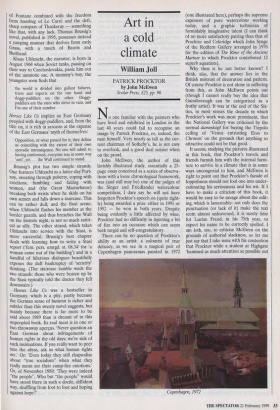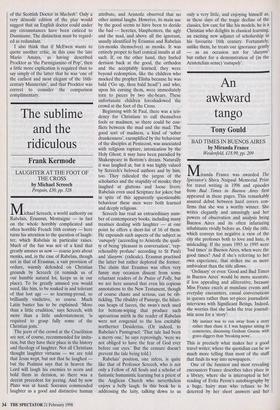Art in a cold climate
William Joll
PATRICK PROCKTOR by John McEwen Scolar Press, £25, pp. 96 No one familiar with the painters who have lived and exhibited in London in the last 40 years could fail to recognise an image by Patrick Procktor, or, indeed, the man himself. Very nearly as tall as the cur- rent chairman of Sotheby's, he is not easy to overlook, and a good deal noisier when on the prowl.
John McEwen, the author of this lavishly illustrated study, essentially a 25- page essay conceived as a series of observa- tions with a loose chronological framework, was (and still may be) one of the judges of the Singer and Friedlander watercolour competition; I dare say he will not have forgotten Procktor's speech on (quite right- ly) being awarded a prize either in 1991 or 1992 — he won in both years. Despite being evidently a little affected by wine, Procktor had no difficulty in injecting a bit of fizz into an occasion which can seem both turgid and self-congratulatory.
There can be no question of Procktor's ability as an artist: a colourist of true delicacy, as we see in a magical pair of Copenhagen panoramas painted in 1972 (one illustrated here), perhaps the supreme exponent of pure watercolour working today, and a graphic technician of formidably imaginative talent (I can think of no more satisfactory pairing than that of Procktor and Coleridge which John Synge of the Redfern Gallery arranged in 1976 for the edition of The Rime of the Ancient Mariner to which Procktor contributed 12 superb aquatints).
Why then is he not better known? I think, alas, that the answer lies in the British mistrust of decoration and pattern. Of course Procktor is not alone in suffering from this, as John McEwen points out (though I cannot really buy the idea that Gainsborough can be categorised as a frothy artist). It was at the end of the Six- ties, in most senses the decade in which Procktor's work was most prominent, that the National Gallery was criticised by the normal dummkopf for buying the Tiepolo ceiling of 'Venus entrusting Eros to Chronos' on the grounds that anything so attractive could not be that good.
It seems, studying the pictures illustrated in this book, that Procktor's travels and friends furnish him with the internal furni- ture to survive in a climate that is in some ways uncongenial to him, and McEwen is right to point out that Procktor's facade of foppishness should not fool one into under- estimating his seriousness and his wit. If I have to make a criticism of this book, it would be easy to be savage about the edit- ing, which is lamentable: not only does the punctuation (or lack of it) make the text seem almost unleavened, it is surely time for Lucian Freud, in his 75th year, to expect his name to be correctly spelled. I am loth, too, to criticise McEwen on the grounds of authorial slackness, so let me just say that I take issue with his contention that Procktor while a student at Highgate `hammed as much attention as possible out Copenhagen, 1972 of the Scottish Doctor in Macbeth'. Only a very demode edition of the play would suggest that an English doctor could under any circumstances have been enticed to Dunsinane. The distinction must be regard- ed as redundant.
I also think that if McEwen wants to quote another critic, in this case the late Mario Amaya, as having described Procktor as 'the Parmigianino of Pop', then a little more explication is required than to say simply of the latter that he was 'one of the earliest and most elegant of the 16th- century Mannerists', and that Procktor was correct to consider the comparison complimentary.



























































 Previous page
Previous page